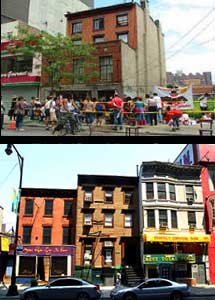 231 Duffield is still standing, but it has been gutted and looks like its shell will only last a few more days at most. Much of the press attention has focused on 227 Duffield (owned by Joy Chatel) and 233 Duffield, but I wanted to take a moment to remember the historical importance of 231 Duffield.
231 Duffield is still standing, but it has been gutted and looks like its shell will only last a few more days at most. Much of the press attention has focused on 227 Duffield (owned by Joy Chatel) and 233 Duffield, but I wanted to take a moment to remember the historical importance of 231 Duffield.In this memorial posting about the building, I would like to go back to the NYC Economic Development Corporation report titled “Research Report on the Potential Underground Railroad Associations of the Duffield Street and Gold Street Properties in Downtown Brooklyn.” Before getting to the connection to the Abolitionist movement, here's a bit of background:
231 DUFFIELD STREET (BLOCK 146, LOT 13)
Lot 13 originally was part of the John Duffield estate. By 1829, Lot 13 (along with other adjacent lots) had been acquired by John Duffield’s daughter, Susan Lawrence. It appears that Susan Lawrence never developed the lot during the time she held it…. Lot 13 was purchased at public auction for $550 by Robert Dingee of Brooklyn. It appears that lot remained undeveloped during the time that Robert Dingee owned it, from 1847 to 1850. In 1850, Robert and Frances Dingee sold Lot 13 to John A. Ackeley (also spelled Ackley) for $800. Again, the relatively low price paid for the lot suggests there were no improvements to it at the time. After purchasing Lot 13, Ackeley appears to have built the first house on the property after 1850.
One of the Peer Reviewers hired by the EDC in this study was Dr. Judith Wellman. Her widely used Wellman Scale evaluates the significance of potential Underground Railroad sites. A level three is defined as
Good chance the story is true Abolitionist sympathies, abolitionism or African-American background but no direct evidence of Underground Railroad activity. Potential Underground Railroad affiliation backed by oral tradition and/or some evidence of abolitionist activity, e.g., antislavery society membership, signatures on antislavery petitions or antislavery church membership.
In Appendix B page 3 of the EDC study, Dr. Wellman writes:
I would definitely put the Hawes/Hilles household (231 Duffield) at a level three because of the Hawes connection with Plymouth Church and the Hilles family as African American. Similarly, I would put the Truesdale/Harris household (227 Duffield) at level three because of Elizabeth Harris’s birthplace in North Carolina and Thomas Truesdale’s subscription to the National Anti-Slavery Standard. I was not sure about which households several other members of abolitionist churches belonged to. The Truesdales and Hawes families (especially the Truesdales) deserve further work. Level 3 fits people who have some connection with abolitionism, even if there is no documented connection as yet with the Underground Railroad. Membership in abolitionist societies and churches and subscription to abolitionist newspapers would count as abolitionist connections.
Dr. Wellman commented several times in the EDC report about the significance of the 231 Duffield, and Dr. Cheryl LaRoche supported Wellman in her comments.
